It’s been too long since we’ve been in a test car that’s not an EV or a hybrid. The Hyundai Kona 1.6T Limited AWD (we agree, the name is too long) is at the top of the spec tree for the Kona range, with only the hybrid version topping it for cost.
DriveLIfe attended the launch of the Kona back in November, and due to cancelled flights, ended up driving the new model 600km back to Wellington. That experience was a good one, so surely the top-spec model would be even better – right?

What We Like and Dislike About The 2023 Hyundai Kona 1.6T Limited AWD
| What we like | What we don’t like |
| Smooth, torquey engine Design Interior Steering wheel controls Ride quality Turning circle Infotainment usability Well equipped Actual aircon buttons | Adaptive cruise control slow to respond A few tech glitches in our test car Upper end of the price range Adaptive cruise can be slow to respond A few glitches in our test car 4-Star safety rating Not much brake feel |
What’s In The 2023 Hyundai Kona Range?
There’s a huge range of models of Kona available:
- Kona 2.0 Active $42,990
- Kona 2.0 Active N Line $49,990
- Kona 1.6 Hybrid Active $52,990
- Kona 1.6 Hybrid Active N Line $59,990
- Kona 1.6 Hybrid Elite $59,990
- Kona 2.0 Elite $49,990
- Kona 1.6T Limited N Line AWD (tested) – $64,990
- Kona 1.6 Hybrid Limited N Line $65,990
All 2.0-litre models have a 4-cylinder engine that manages 110kW of power and 180Nm of torque, along with a constantly variable automatic transmission. These models are rated at using 7.3 litres of petrol per 100km.
The 1.6 hybrid models have a 1600cc 4-cylinder engine that puts out 77kW of power and 147Nm of torque. The electric motor in the hybrid is 32kW/170Nm, and that means when combined with the petrol motor, this raises to a total of 104kW and 265Nm. Hybrid models have a 6-speed dual-clutch transmission (DCT). The hybrid Kona is rated at 4.3L/100km.
The 1.6T model is the only turbocharged Kona and manages 146kW of power and 265Nm of torque. This car runs an 8-speed automatic transmission (so not a dual-clutch). The 1.6T Limited N Line is the only all-wheel drive Kona, with the rest of the Kona range being front-wheel drive. This model is rated at 8.5L/100km.

2023 Hyundai Kona Standard Equipment Highlights
Active models:
- 17” alloy wheels
- Electric park brake with auto-hold
- Tyre pressure monitoring system
- Tilt/telescoping steering wheel
- Blind-Spot Collision Avoidance
- Rear Cross Traffic Alert
- Forward Collision-Avoidance including pedestrians and cyclists
- Lane Keep Assist
- Lane Following Assist
- Adaptive cruise control with stop/go
- Traffic Sign Recognition
- Automatic high beams
- Driver Status Monitor
- Rear Occupant Alert
- Auto-dipping rearview mirror
- Automatic headlights
- Automatic wipers
- Front and rear parking sonar
- Reversing camera
- Electrically folding and heated mirrors
- LED DRLs
- LED taillights
- Leather steering wheel
- Qi wireless phone charging
- Keyless entry and start
- 12.3” centre touchscreen
- Climate dual-zone AC
N Line models add:
- N Line specific exterior trim
- LED headlights
- N Line specific leather & Alcantara interior trim
Elite models add:
- 18” alloy wheels
- Rear privacy glass
- Electric driver’s seat, 8-way
- Leather interior
- Electric passenger seat, 6-way
- Heated front seats
- LED interior ambient lighting
- SatNav
- Bose 8-speaker audio
- 12.3” driver’s display
Limited models add:
- 19” alloy wheels
- Blind-spot View Monitor
- Reversing Collision-Avoidance Assist
- Surround View Monitor (360-degree camera)
- Remote Spark Parking Assist
- Electric tailgate
- Electric driver’s seat, 10-way
- Driver & Passenger – Relaxation comfort seat function (zero gravity position)
- Ventilated front seats
- Heated steering wheel
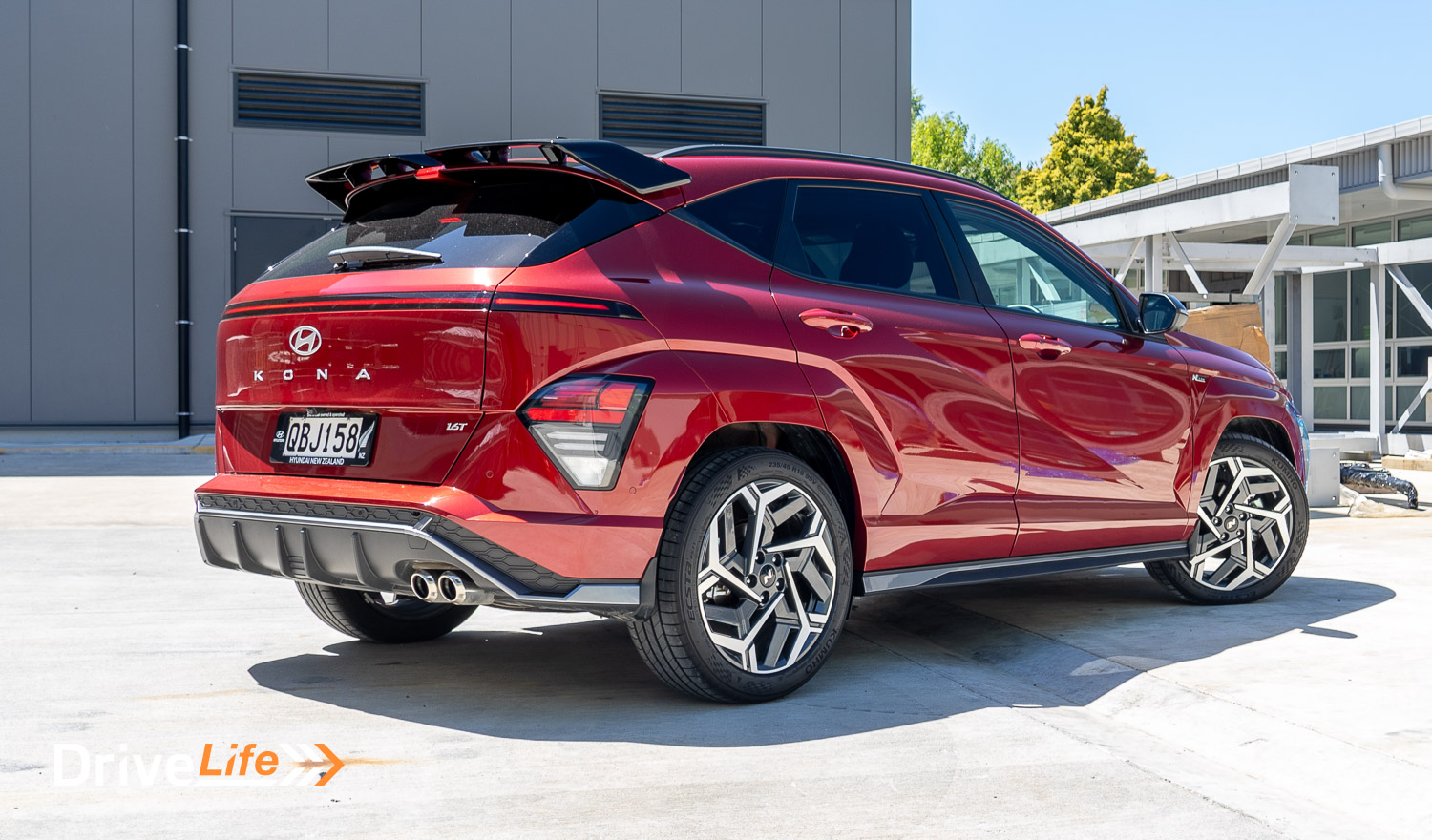
2023 Hyundai Kona Colour Range
There are ten colours to choose from, with a dual colour (black roof) option. The colours are:
- Abyss Black
- Atlas White
- Cyber Grey
- Ecotronic Grey
- Ultimate Red
- Soultronic Orange
- Neoteric Yellow
- Mirage Green
- Meta Blue
- Denim Blue
Our review car had no optional equipment so the retail price is $64,990.
For a full list of specs and options available for the Hyundai Kona head on over to the Hyundai New Zealand’s website.
How Does The 2023 Hyundai Kona 1.6T Limited AWD Compare To Its Competition?
| Make/ Model | Engine | Power/ Torque kW/Nm | Seats | Fuel L/100km | Boot Space litres | Price |
| VW T-Roc R (AWD) | 2.0-litre, 4-cylinder turbocharged petrol | 221/400 | 5 | 9.3 | 392 | $69,990 |
| Skoda Karoq Sportline TSI (AWD) | 2.0-litre, 4-cylinder turbocharged petrol | 140/320 | 5 | 7.3 | 500 | $64,990 |
| Hyundai Kona 1.6T Limited AWD | 1.6-litre, 4-cylinder, turbocharged petrol | 146/265 | 5 | 8.5 | 407 | $64,990 |
| Nissan Qashqai Ti-L e-Power (2WD) | 1.5-litre 3-cylinder hybrid | 140/330 | 5 | 5.8 | 452 | $60,990 |
| Kia Niro HEV GT-Line (2WD) | 1.6-litre 4-cylinder hybrid | 104.265 | 5 | 4.4 | 451 | $59,990 |
| Honda ZR-V Sport (2WD) | 2.0-litre, 4-cylinder petrol hybrid | 135/315 | 5 | 4.9 | 370 | $55,000 |
Please note that DriveLife does its best to ensure the information below is correct at the time of publication, however, prices, specifications and models can change over time. Please bear that in mind when comparing models in the comparison table.

First Impressions Of The 2023 Hyundai Kona 1.6T Limited AWD
Finished in Ultimate Red, our test car looked superb. That frontal design with the Staria-like light bar, the head and fog lamps on the extremities, and the way the C-pillar kicks up at the rear to join the roof spoiler…it all adds up to a striking car. Gone are the days when all cars were starting to look alike when you have designs like the 2024 Hyundai Kona driving about.

The roof spoiler alone is a work of art, nicely formed and integrated, yet it looks purposeful too. It provides a real sense of sportiness to the Kona 1.6T Limited N-Line.

There’s a lot happening at the rear of the Kona, with a diffuser down low, along with some very sexy dual exhaust tips. The light-bar treatment from the front of the Kona is replicated across the tailgate, adding some nice symmetry to the design.
All in all, it’s an outstanding design, especially in Ultimate Red. That colour and that design turned a lot of heads during my time with the car.
What’s The Interior Like In The 2023 Hyundai Kona 1.6T Limited AWD?
With red stitching on the seats and steering wheel, you can feel the sporty side of the Kona 1.6T N Line Limited when you step inside. Added to this are the red lines down the centre of the front seats and dashboard, and alloy pedals complete the sporty-pretensions picture. Perhaps it’s the sporty intentions of the car, but the whole interior is black; this can make a car feel claustrophobic, but there is an electric sunroof with an electric blind to try and help it feel less so.
Another feature that helps the car feel bigger inside is the centre console; it’s quite low, as in on the floor, and this gives a real sense of space to the front seat occupants. The dashboard and centre screen are in a curved display fashion, something that we are seeing a lot of across all brands. It looks tidy, futuristic and impressive, and is another feature that adds to that sense of space, compared to a tacked-on screen overhanging the central area of the car.

That console has a small cubby at the rear, and then storage space underneath the cubby as well. Generally speaking, storage is well taken care of here, with a glovebox that’s surprisingly large for the size of the car, and a cellphone shelf above the glovebox.
I’m happy to report that like the other Kona models, the aircon controls are still physical buttons and dials, and long may they stay. I happened to spend a couple of days in the new Omoda C5 during my stint with the Kona, and while the C5’s touch controls for AC worked, they were nowhere near as effective as those in the Kona. Another actual knob fitted to the Kona is a volume knob – on the passenger’s side of course, but still better than trying to use slider controls for volume adjustment.

Connectivity includes 2 USB-C ports in the front, along with a 12-volt socket for your webcam. These are just above the Qi wireless phone charging pad.
The Kona 1.6T Limited N Line AWD is the top-spec model in the Kona range, and it doesn’t leave you wanting for much. You’ll find heated and cooled seats (3 settings for each), electric front seats with memory settings for the driver, as well as a 2-stage heated steering wheel. Only a heads-up display seems to be missing from the list of features.
Rear seat space is around average, it would be great for the occasional trip with the grandkids. The boot is a good size at 407 litres, about average for the class, and under the floor is a space-saver spare. Thankfully, the loading height on the Kona is fairly low.




What’s The 2023 Hyundai Kona 1.6T Limited AWD Like To Drive?
On getting into the Kona 1.6T and pulling away from the dealership, the performance of the car is revealed instantly. It feels so damn torquey, and quiet. It will be interesting to see what it’s like to live with this car for a week.
The top-spec Kona has a nice feature where the steering wheel will vibrate if you are reversing out of a spot and there is a car approaching from anywhere behind you. This is just one of the many driver assistance systems in the Kona, and it works brilliantly.
Another electronic driver aid is the Driver Status Monitor. We are seeing this in just about every car we test now, and it is destined to become part of the ANCAP safety ratings system. We’ve had mixed success with these driver eyesight systems; they monitor the driver’s eyes and if you look away for too long – a good example is someone looking at a cellphone – the system will warn you. Warnings vary from bings and sounds to a dashboard warning light.
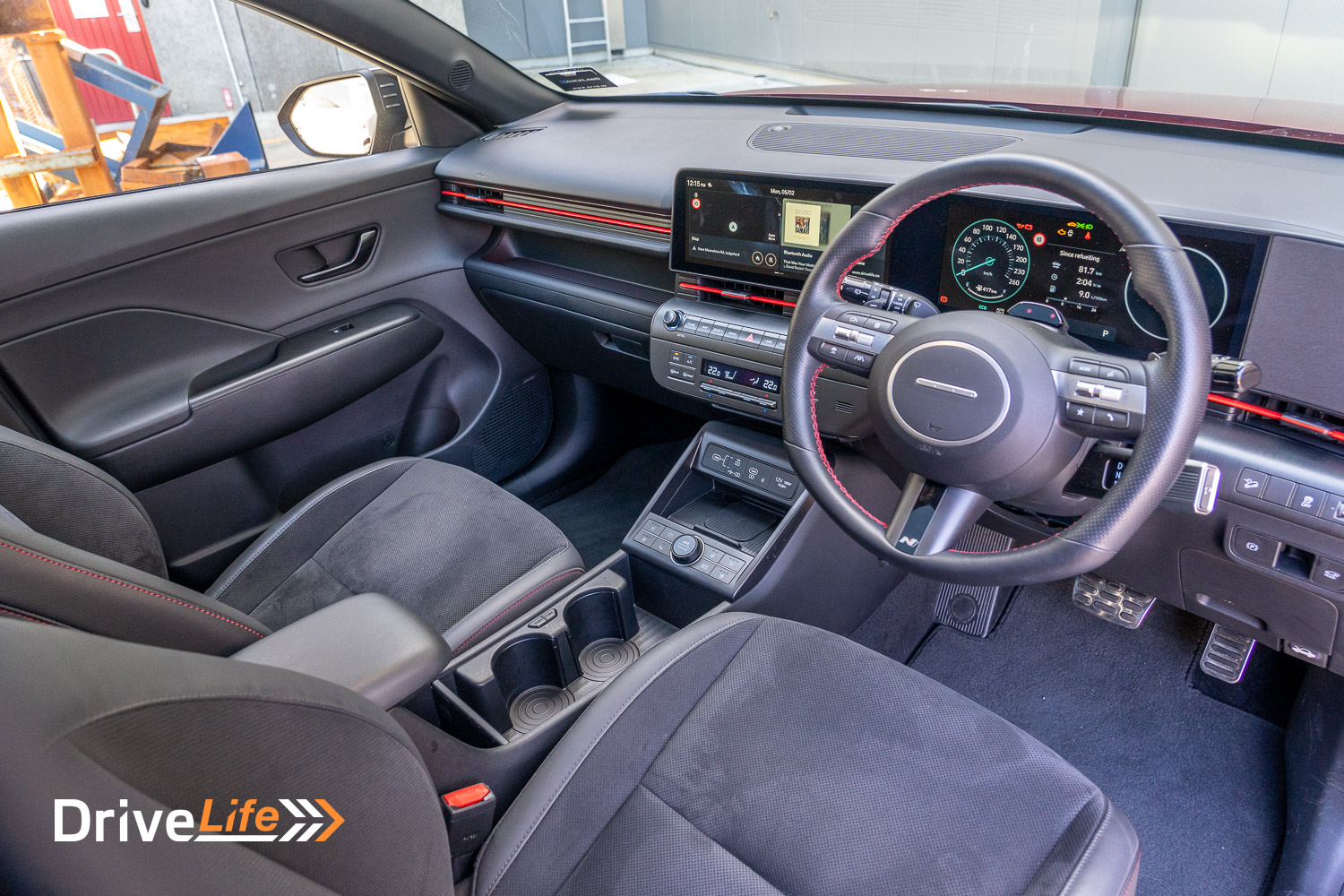
At this time, most of these systems give too many false positives, and the Kona is no exception to this. While its Driver Status Monitor system works well enough half of the time, just looking at the outside mirror or even at the speedo will sometimes see the system giving you a growling. We’re sure in time these will improve, as some manufacturers already have them working well.
This means that with a beep when you are looking at the speedo and are warned about distractions along with another beep if you go over the speed limit, expect more beeping noises than you might want. It’s not overbearing, but some of the beeps turn to white noise and end up being ignored, which I am sure wasn’t the purpose of the systems.
Another couple of common Hyundai safety assistance systems are fitted to the Kona 1.6T, like the safe exit alert, where the car will alert you if you are about to open a door and there’s (for example) a cyclist coming, or a car. This is great for kids in the back seat, who might be too busy on their phone to even think about looking for other traffic before whipping their door open. There’s also the Blind-spot View Monitor, common to Hyundai and Kia models. This changes the speedo or rev counter to a blind-spot camera on each side of the car. Turning on your left indicator will see the speedo switch to the left-hand camera, for example. It takes a bit to get used to, but again, another great safety feature.

There are other great safety features that aren’t electronic, like the sliding sun visors. These are brilliant for cutting out the sun when it’s in the corner of the driver’s door, and it’s not a common feature like you’d think it should be.
Like all models of Kona, the car is fitted with adaptive cruise control. Another great feature and it certainly helped on that 600km drive to Wellington that we did. If there’s a ‘but’ here, it’s that the adaptive cruise control in the Kona is too slow to respond. For example, when changing lanes on the motorway and then expecting the Kona to accelerate away, you are left waiting. The car will slowly accelerate, but then you might have traffic behind you, waiting for you to move it along. I’d often use the accelerator pedal to get the car back up to speed and then let it settle into adaptive cruise control mode. Not a huge thing, but quite frustrating.

The adaptive cruise fitted to the Kona will bring the car to a stop, and this is something that is not common across all brands and models yet. If the car does need to stop when using adaptive cruise, a tap of the gas pedal or flicking the cruise speed adjust button up or down will set the car off again.
Along with adaptive cruise, the 1.6T has self-steering (“Lane Following Assist”), where the car will assist the driver in staying in the lane. This is pretty common on many cars, and the Kona goes one step further where you do not have to be using adaptive cruise control in order to use self-steering. I did find that while it generally works well in the Kona, it does tend to hug the centre line.
On the Daily Drive, the Kona 1.6T is a nice place to live. I love the feature that automatically turns the AC to recirculate when you are going through a tunnel, “for your comfort” says the car. Nice touch. Helping in city driving is an excellent turning circle of 10.6 metres, nicely tight, especially for Wellington’s streets and alleys.

The new Kona is fitted with the latest version of Hyundai’s user interface for the centre screen, and it’s very good. It’s quick, simple to learn and the resolution of the screen is excellent. No complaints here and a much better system than the previous generation.
After getting out of the Mercedes-Benz EQE with its haptic steering wheel controls and into the Kona, well, the Kona is miles ahead. There are normal, standard buttons for controlling adaptive cruise control, audio, and other settings and they work perfectly. My favourite feature of steering wheel controls is a thumbwheel for managing audio volume, and the Kona has one. All the steering wheel controls are simple and easy to use and are learnt very quickly.
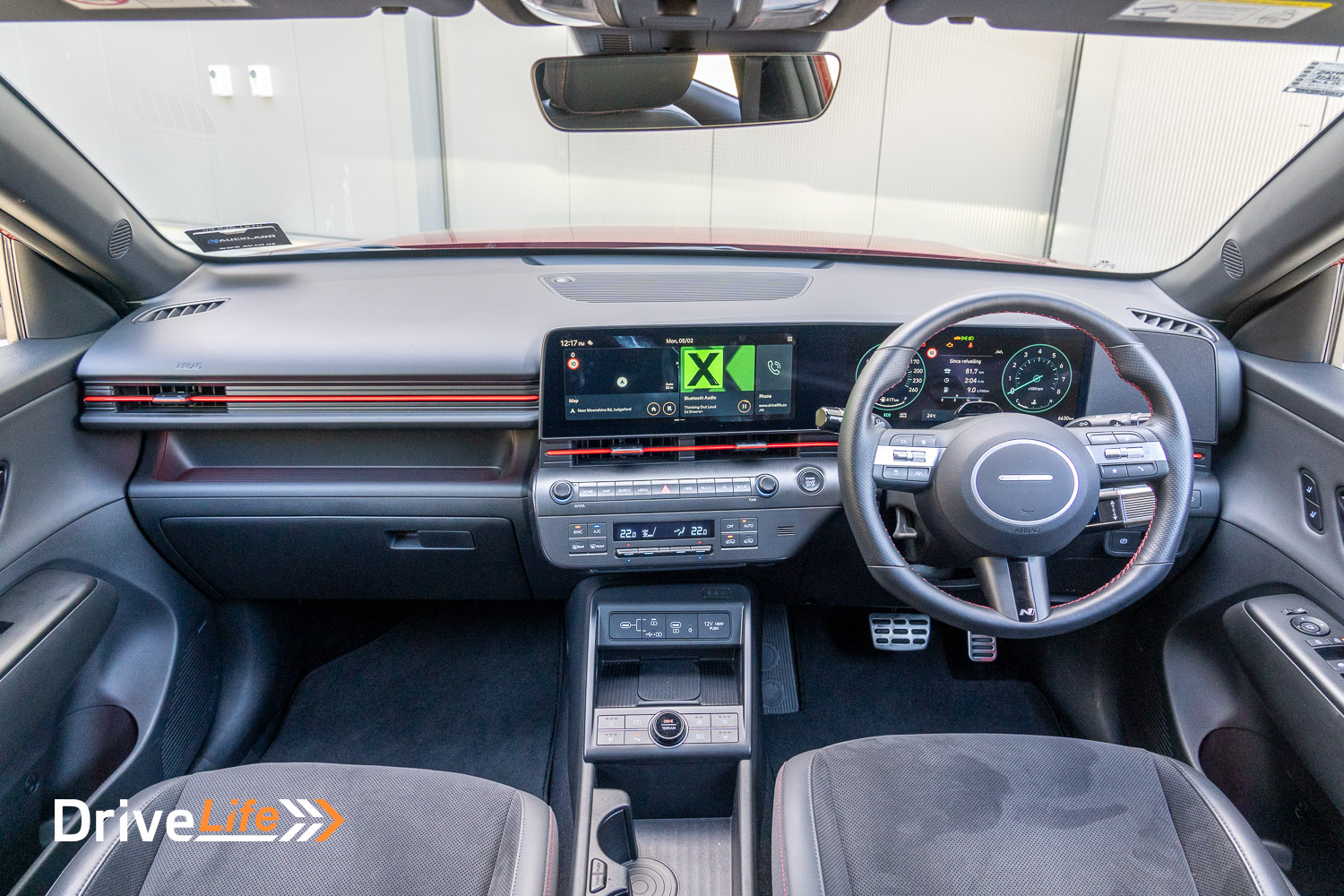
The ride quality in the car is excellent, especially considering it has larger wheels than the other models. The tyres are 45 profile too, so fairly low, and yet the Kona glides along bumpy roads quite nicely. Khumo ECSTA tyres Are fitted to the 1.6T model, and tyre noise is generally low, allowing for coarse-chip seal, one of those read surfaces where nearly all tyres like to sing the song of their people. Wind noise is very well controlled, and other than a slight noise coming from the top of the A-pillar when on the motorway, it is fairly non-existent.
While the Kona 1.6T Limited AWD doesn’t pretend to be an off-roader, there is a button for Hill Descent Control, so that’s a bonus. One of the dashboard’s displays will show you how much drive is going to each end of the car at any time if that’s your thing. You do get some “terrain” modes with the car, where you can choose from Snow, Mud, or Sand, and the Kona’s electronics will assist you with the best possible settings for grip.
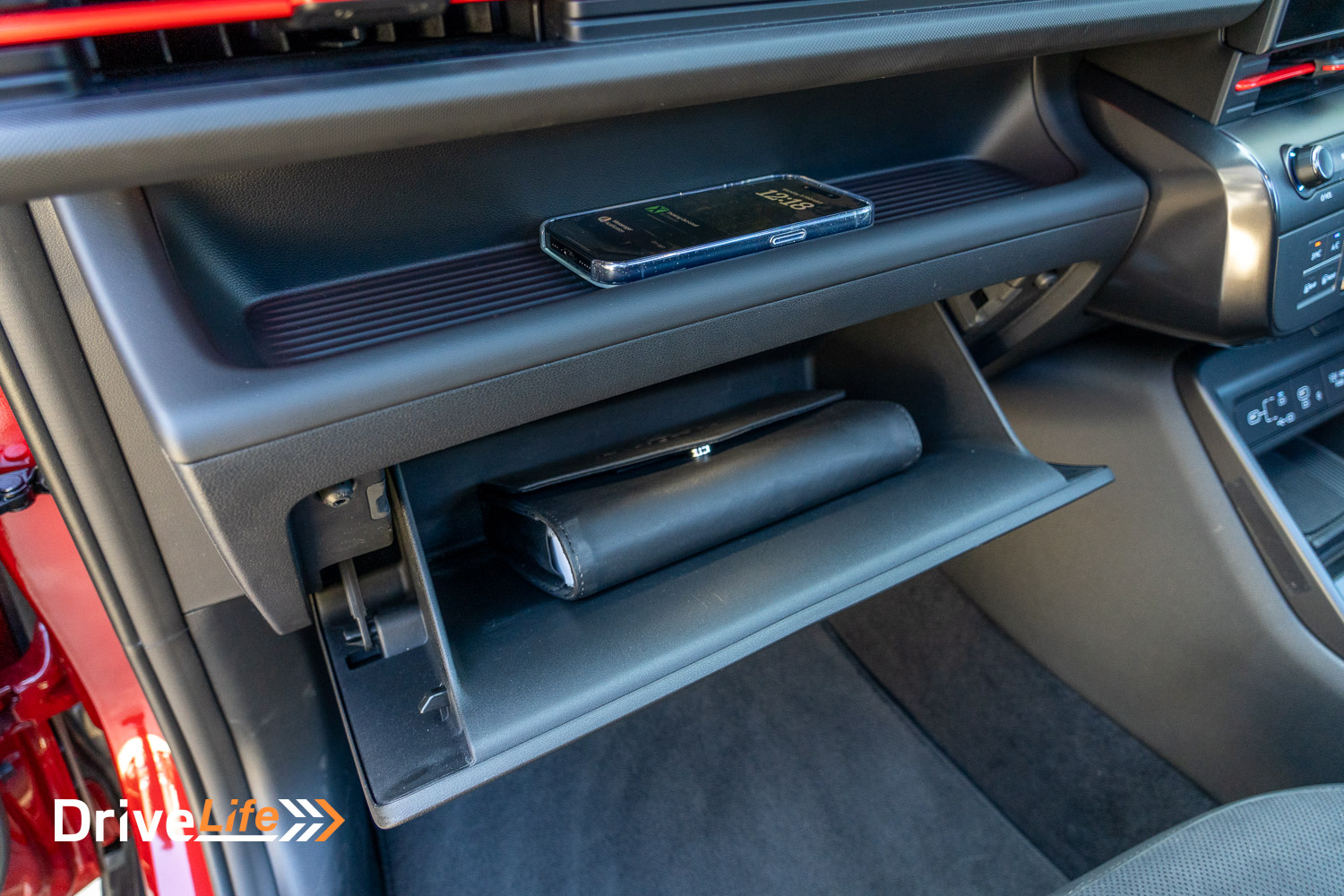
If there were a few places where Hyundai could improve the Kona, for me it would be the brakes. They are powerful enough but can feel pretty wooden, making it harder to come to a smooth stop at times.
When I drove the hybrid version back from Auckland, I did find that it ran out of steam in the upper rev range. Surely the 1.6 turbo model doesn’t suffer from this? It doesn’t, and the car pulls hard right to the red line. It has a nice tone to it too, and in general running about and on the motorway, the engine is a model of civility and smoothness. It’s extremely torquey too, meaning passing manoeuvres are quick and easy.

The turbo model of Kona is the only one to get a ‘normal’ automatic transmission. It’s an 8-speed unit that’s relatively well matched to the engine, although it does suffer from the occasional pause where it isn’t sure if it wants to kick down or not.
I had a couple of small glitches in our test Kona; the remote start button on the keyfob just wouldn’t work, and the voice command button on the steering wheel didn’t work either. It’s pretty rare to find anything not working in a new car, so I expect these are one-off issues with our test car.
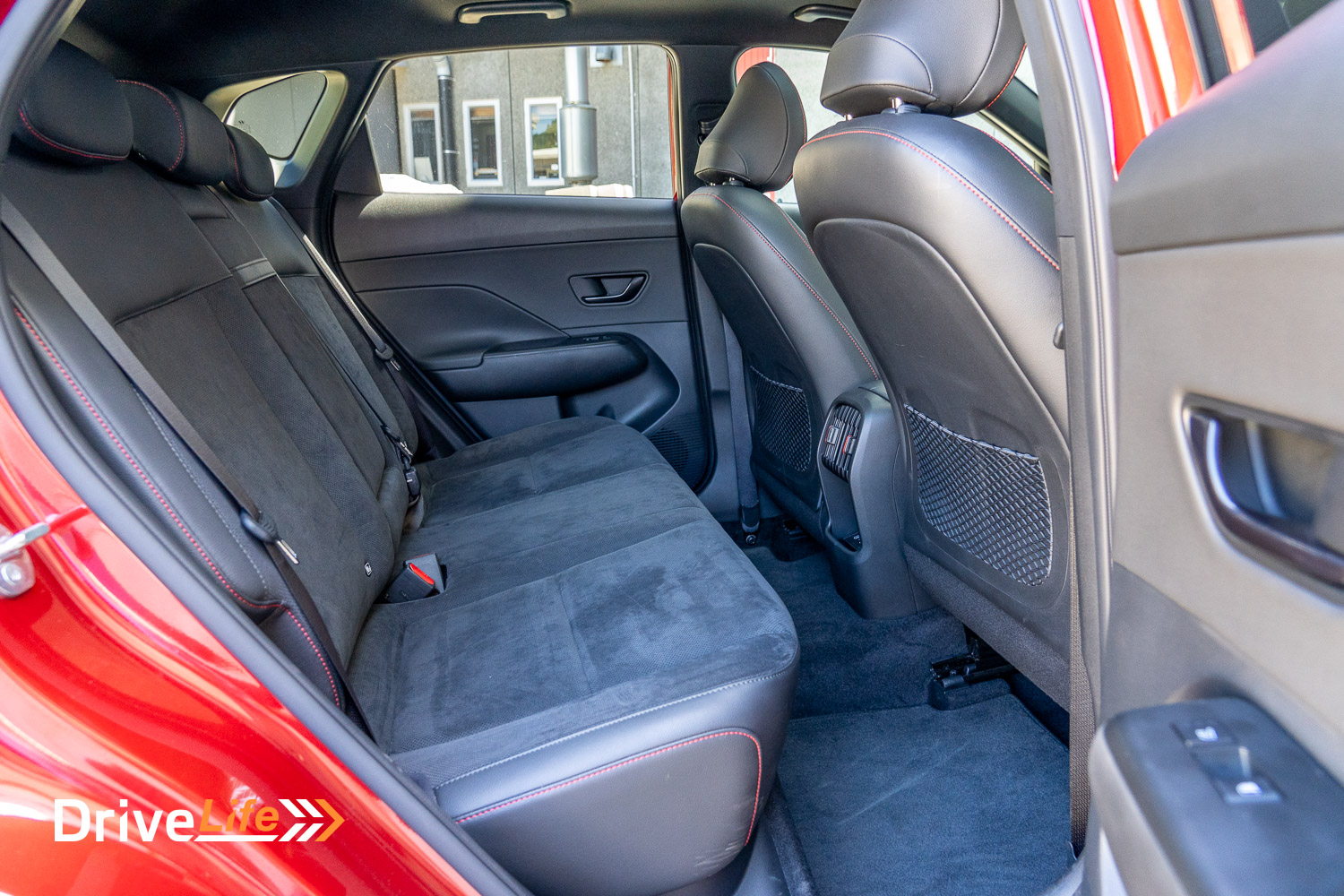
One feature the 1.6T model gets above all other grades of Kona is the Remote Spark Parking Assist feature. This means you can drive the car forward or backwards, from outside the car – at low speeds of course. You aren’t James Bond. It’s mainly targeted to those times when you want to get your car out of (or into) a carpark that is pretty tight and you wouldn’t be able to open your door. Using the key fob, you can move the car forwards or backwards easily. If someone walks in front or behind the car while it’s moving, it will stop. I have used the feature before, and it’s pretty handy. While we’re talking about the keyfob, I have to say it’s one of the biggest I’ve ever seen. You’ll certainly feel it in your pocket.
Drivers get to pick from 3 drive modes, on top of the terrain modes; Eco, Normal, and Sport. Eco mode certainly dulls the performance down, and I found it just too lethargic to use on a day-to-day basis. Sport mode will of course make the car more peppy and eager, but honestly, Normal mode did it for me every time. It’s a good combo of just-right settings to make for an enjoyable drive. Regardless of using the car in Normal mode most of the time (and not Eco mode), I managed to get 8.3L/100km over 500km of driving, slightly less than what Hyundai suggests the car should return. This compares to the 5.3L/100km I got from the hybrid on that Auckland to Wellington drive.

2023 Hyundai Kona 1.6T Limited AWD – Specifications
| Vehicle Type | Small/medium 5-door SUV |
| Starting Price | $64,990 |
| Price as Tested | $64,990 |
| Engine | 1.6-litre, 4-cylinder turbocharged petrol |
| Power, Torque kW/Nm | 146/265 |
| Transmission | 8-speed automatic |
| Spare Wheel | Space saver |
| Kerb Weight, Kg | 1,450 |
| Length x Width x Height mm | 4385x1825x1590 |
| Boot Space / Cargo Capacity, Litres (seats up/seats down) | 407/1,241 |
| Fuel tank capacity, litres | 47 |
| Fuel Economy, L/100km | Advertised Spec – Combined – 8.5 Real-World Test – Combined – 8.3 Low Usage: 0-6 / Medium Usage 6-12 / High Usage 12+ |
| Towing Capacity Kg, unbraked/braked | 600/1,300 |
| Turning circle metres | 10.6 Small: 6-10m / Medium 10-12m / Large 12m+ |
| Warranty | 5 year/150,000km factory warranty 10 year/200,000km anti-perforation corrosion warranty 5 year/150,000km Roadside Assistance |
| Safety information | ANCAP Rating – 4 stars – Link Rightcar.govt.nz – 4 Stars – QBJ150 |
Have you enjoyed this review? Be sure to join our monthly email newsletter list so you don’t miss a single car review!








